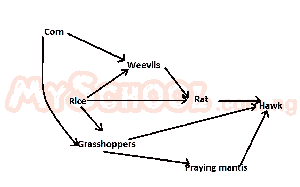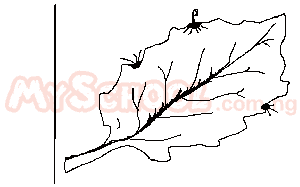Water loss is regulated in plants and animals by both the
- A. scales and the skin
- B. scales and the hair
- C. thick leaves and the feathers
- D. leathery cuticle and the feathers
Long neck in giraffe is used to illustrate the theory of
- A. use and disuse
- B. origin of species
- C. origin of life
- D. natural selection
Fossil records found in sedimentary rocks offer some explanation for the theory of evolution because
- A. the deposits have remains of organisms characteristic of when they were formed
- B. different strata have remains of organisms of the same kind
- C. only organisms with strong parts are fossilized
- D. most animal and plant fossils bear little resemblance to present day living specimens
What combination of character should a prey develop to survive the environment of its predator?
- A. Camouflag, well developed limbs and effective vision
- B. Showy colour, big body and well developed limbs
- C. Camouflage, big body and effective vision
- D. Showy colour, well developed muscles and an acute sense of smell
Which of the following characters is NOT sex-linked?
- A. Albinism
- B. Baldness
- C. Haemophilia
- D. Colour blindness
The homozygous condition HbsHbsresults in sickle cell anaemia whereas HbAHbs has the sickling trait. What is the probability that a couple with the sickling trait will give birth to one normal child?
- A. 1/2
- B. 1/4
- C. 1/8
- D. none
One reason for the success of Mendel’s work is that the
- A. was the first to carry out research work on modern genetics
- B. introduced quantitative and qualitative elements into his work
- C. selected two characteristics only at a time for study
- D. drew up his laws of inheritance based on his knowledge of chromosomes
During binary fission in lower organisms, the nucleus is known to undergo
- A. mitosis
- B. meiosis
- C. fragmentation
- D. mutation
One of the most effective ways of controlling guinea worm is by
- A. treating the disease
- B. public enlightenment campaigns
- C. accelerating rural developmnet
- D. provision of portable drinking water
Which is the most important pollutant of the marine environment in Nigeria?
- A. Insecticides
- B. Sewage
- C. Oil
- D. Inorganic fertilizers
In a soil sample, the relative amouunts of the different soil particles can best be determined by the process of
- A. filtration
- B. centrifugation
- C. precipitation
- D. sedimentation
After a heavy rainfall and the formation of a large pond, the most likely sequence of changes in the vegetation of the pond is
- A. Euglena → water lily → Spirogyra → grass
- B. water lily → Spirogyra →grass → Euglena
- C. Spirogyra → Euglena → grass → water lily
- D. Euglena → Spirogyra → water lily → grass
The Southern Guinea Savanna differs from the Northern Guinea Savanna in that it has
- A. lower rainfall and shorter grasses
- B. less grasses and scattered trees
- C. more rainfall and taller grasses
- D. less arboreal and burrowing animals
Adaptive features of plants to desert conditions include?
- A. thick barks, succulent stems and sunken stomata
- B. thin barks, succulent stems and sunken stomata
- C. thin barks, air floats on stems and sunken stomata
- D. air spaces in tissues, adventitious roots and thick barks
Toads and lizards in an ecosystem depend on a limited quantity of food. This is an example of
- A. parasitism
- B. intraspecific competition
- C. predation
- D. interspecific competition

Which organism in the food-web illustrated above is an omnivore?
- A. Weevils
- B. Rat
- C. Hawk
- D. Prayer mantis
The speed of wind can be measured with an instrument called
- A. hygrometer
- B. secchi disc
- C. anemometer
- D. wind vane
The ability of the eye to focus on both near and distant objects is termed
- A. image formation
- B. refraction
- C. hypermetropia
- D. Accomodation
The part of the brain that regulates most biological cycles in humans is
- A. olfactory lobe
- B. optic lobe
- C. medulla oblongata
- D. pineal body
The substance that is responsible for optical dominance in plants is known as
- A. gibberellin
- B. tannin
- C. auxin
- D. kinin

coconut and oil palm fruits can be grouped as
- A. berry
- B. legume
- C. capsule
- D. drupe


